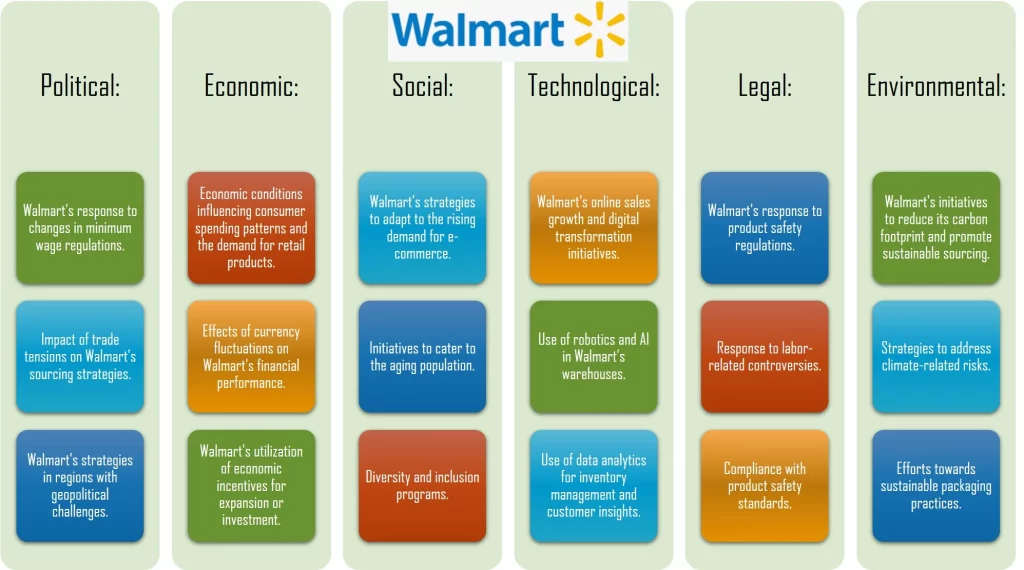
Below is a sample PESTLE analysis essay on Walmart Inc. This example is intended to help students write better business PESTLE analysis essays.
Walmart PESTLE Analysis Essay
PESTLE Analysis Essay Outline: Walmart Inc.
Here is the outline for this sample PESTLE analysis essay:
- Introduction
- Brief introduction to Walmart, emphasizing its global presence and impact on the retail industry.
- Significance of conducting a PESTLE analysis for Walmart’s strategic evaluation.
- Purpose of the essay: to analyze the external macro-environmental factors affecting Walmart.
- Political Factors
- Government Regulations
- Exploration of government regulations affecting Walmart’s operations, including labor laws and product safety standards.
- Example: Analysis of Walmart’s response to changes in minimum wage regulations.
- International Trade Policies
- Examination of how global trade policies, tariffs, and trade agreements impact Walmart’s supply chain and pricing strategies.
- Example: Evaluation of the impact of trade tensions on Walmart’s sourcing strategies.
- Political Stability
- Discussion on the importance of political stability in the countries where Walmart operates and its influence on business operations.
- Example: Analysis of Walmart’s strategies in regions with geopolitical challenges.
- Economic Factors
- Consumer Spending Patterns
- Analysis of economic conditions influencing consumer spending patterns and the demand for retail products.
- Example: Consideration of Walmart’s performance during economic downturns and recessions.
- Currency Exchange Rates
- Examination of how currency exchange rates impact Walmart’s international operations and pricing strategies.
- Example: Analysis of the effects of currency fluctuations on Walmart’s financial performance.
- Economic Incentives
- Exploration of economic incentives, such as tax policies or subsidies, that influence Walmart’s business decisions.
- Example: Assessment of Walmart’s utilization of economic incentives for expansion or investment.
- Social Factors
- Consumer Behavior
- Analysis of societal attitudes towards retail and changing consumer preferences.
- Example: Evaluation of Walmart’s strategies to adapt to the rising demand for e-commerce.
- Demographic Trends
- Examination of demographic trends influencing Walmart’s target market and product offerings.
- Example: Consideration of Walmart’s initiatives to cater to the aging population.
- Diversity and Inclusion
- Discussion on societal expectations regarding diversity and inclusion and Walmart’s initiatives in this regard.
- Example: Assessment of Walmart’s diversity and inclusion programs and their impact on the brand.
- Technological Factors
- E-commerce and Digital Trends
- Analysis of the impact of e-commerce and digital trends on Walmart’s distribution and marketing strategies.
- Example: Evaluation of Walmart’s online sales growth and digital transformation initiatives.
- Automation and Supply Chain Technology
- Examination of technological advancements in supply chain management and automation affecting Walmart’s operations.
- Example: Analysis of Walmart’s use of robotics and AI in its warehouses.
- Data Analytics
- Exploration of how data analytics influences Walmart’s decision-making processes.
- Example: Assessment of Walmart’s use of data analytics for inventory management and customer insights.
- Legal Factors
- Regulatory Compliance
- Analysis of legal considerations related to Walmart’s adherence to regulations and industry standards.
- Example: Evaluation of Walmart’s response to product safety regulations.
- Labor Laws and Employment Practices
- Examination of legal aspects related to labor laws, employment practices, and worker rights.
- Example: Consideration of Walmart’s response to labor-related controversies.
- Product Regulations
- Discussion on legal regulations governing product safety and labeling in the retail industry.
- Example: Assessment of Walmart’s compliance with product safety standards.
- Environmental Factors
- Sustainable Practices
- Analysis of Walmart’s commitment to environmental sustainability in its supply chain and operations.
- Example: Evaluation of Walmart’s initiatives to reduce its carbon footprint and promote sustainable sourcing.
- Climate Change Risks
- Examination of environmental risks, such as climate change, and their potential impact on Walmart’s supply chain.
- Example: Consideration of Walmart’s strategies to address climate-related risks.
- Packaging Sustainability
- Exploration of Walmart’s efforts towards sustainable packaging practices.
- Example: Assessment of Walmart’s use of eco-friendly materials and packaging designs.
- Conclusion
- Summarization of key findings from the PESTLE analysis.
- Implications of external factors for Walmart’s strategic decision-making.
- Overall assessment of Walmart’s resilience and adaptability in the face of macro-environmental changes.

